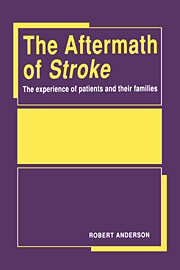Book contents
- Frontmatter
- Contents
- Acknowledgements
- Chapter 1 Stroke: An introduction to the problem
- Chapter 2 The Greenwich stroke study
- Chapter 3 Coming into medical care: the first month after stroke
- Chapter 4 Hospital care and rehabilitation
- Chapter 5 Survival, physical disability and health
- Chapter 6 Support in the community
- Chapter 7 The effects of stroke on social, family and personal life
- Chapter 8 Caring and coping with stroke
- Chapter 9 Resources for coping with stroke
- Appendix: Measurement and scoring of variables
- References
- Index
Appendix: Measurement and scoring of variables
Published online by Cambridge University Press: 07 October 2011
- Frontmatter
- Contents
- Acknowledgements
- Chapter 1 Stroke: An introduction to the problem
- Chapter 2 The Greenwich stroke study
- Chapter 3 Coming into medical care: the first month after stroke
- Chapter 4 Hospital care and rehabilitation
- Chapter 5 Survival, physical disability and health
- Chapter 6 Support in the community
- Chapter 7 The effects of stroke on social, family and personal life
- Chapter 8 Caring and coping with stroke
- Chapter 9 Resources for coping with stroke
- Appendix: Measurement and scoring of variables
- References
- Index
Summary
A study of the factors influencing the quality of life of survivors of stroke and their main carers requires assessments ranging from clinical indicators of severity of stroke to measurement of aspects of stress and strain caused by the illness. The characteristics and lives of patients and their supporters cannot easily be summarised. Features such as disability, emotional distress and social activity are so multifaceted that they demand investigation of many aspects. These specific elements are discussed in the appropriate chapters, but comparisons between people or over time are generally presented in terms of summary scores. These scores have been derived from analysis of several items on ‘measuring instruments’ drawn from a variety of sources. In searching for appropriate instruments it was intended that they should ask questions which were relatively easy to answer, so that the maximum proportion of patients, including those with speech impairments, could give useful responses. The aim was for scoring to be based directly upon the responses of the patients and their supporters rather than on ratings by the researcher. As far as possible the same instruments were used with both patients and supporters.
The principal measures, their derivation, items and scoring are presented here. Items 1–3 describe the tests and assessments of patients that were made by the researcher.
Clinical
(a) Hemianopia/visual inattention: two pen test (Isaacs and Marks, 1973)
The examiner sits immediately opposite the patient and asks the patient to look at his forehead.
- Type
- Chapter
- Information
- The Aftermath of StrokeThe Experience of Patients and their Families, pp. 234 - 248Publisher: Cambridge University PressPrint publication year: 1992



